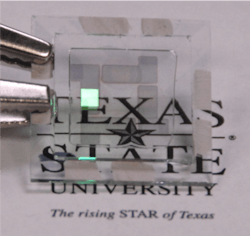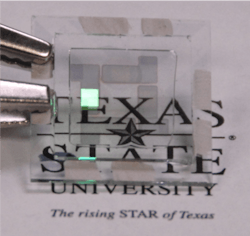Augmented reality medical technology features flexible OLED display
A team of researchers at Texas State University (San Marcos, TX), in collaboration with ArchieMD (Boca Raton, FL), is developing augmented reality medical training technology for the U.S. Army through the U.S. Department of Defense (Washington, DC).
"Typically, if you or I get injured, within 15 minutes we're in a hospital," explains Alex Zakhidov, an assistant professor in the Department of Physics at Texas State. "But soldiers on a mission, involved in an ongoing fight, sometimes they need to wait for several days before they can get treated by a doctor. By that time, unfortunately, the wound aggravates. It becomes even worse."
To train Army physicians to treat such traumatic wounds that progress over time, the Texas State team is developing a thin, flexible organic light-emitting diode (OLED) adhesive display that can be embedded in a moulage (a simulated, prosthetic wound) capable of interacting wirelessly with a smartphone app. Viewed through the app, the wound can evolve, presenting symptoms of infection or other aggravating factors, requiring the physician in training to accurately decide on the proper course of treatment for the wound at that point in time.
A semitransparent OLED test sample is shown.
"This is not a typical wound. It'd be severe trauma, like a gunshot. The wound's appearance changes over time as the situation aggravates," Zakhidov says. "The trainee applies some treatment to help the wound, antibiotics for example, and the display will show how the wound will heal out. It will show the progression: This is how it formed, how it aggravates, and—if the proper treatment is applied—how it heals. Of course, there are several treatment options, and the trainee has to select the right one. The information on the display will help them better understand what is happening."
Zakhidov's team has completed work on a small, proof-of-concept prototype and is currently focused on scalability, reliability, and performance. The OLED must be enlarged while retaining its flexibility so that it can accommodate the contours of the human body as it simulates life-size injuries. Improved performance from the device driver will result in better framerates and increased image resolution.
A protoype of the thin, flexible adhesive display that can deliver information to physicians through a smartphone app allows the proper course of treatment for the wound during specific points in time.
ArchieMD was awarded a two-year, $1 million grant from the U.S. Army for the project, of which Zakhidov's group has received approximately $500,000 to develop the hardware component.
For more information, please visit zakhidov.wp.txstate.edu.


